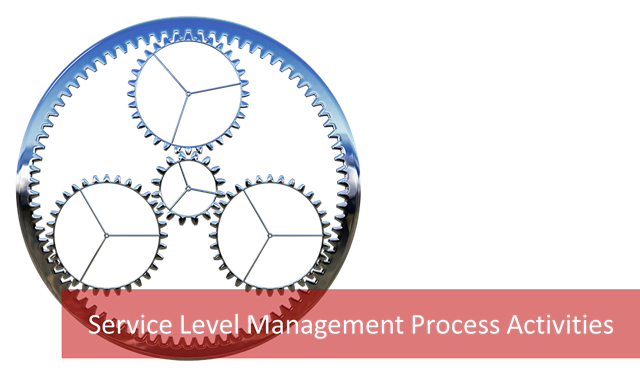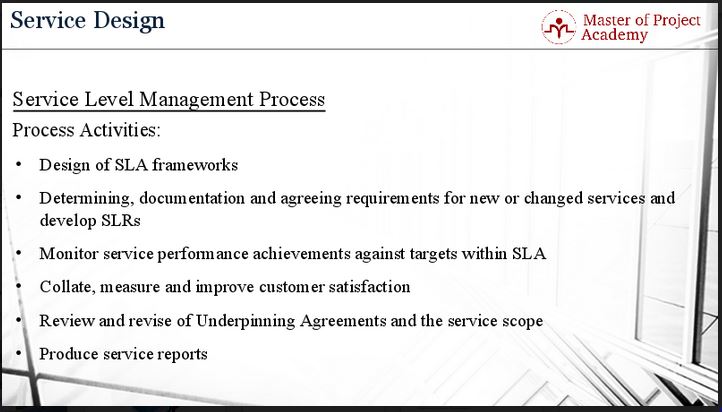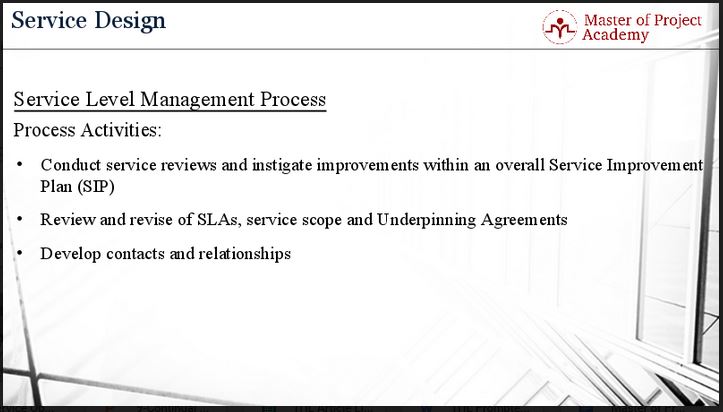The service level management process is an important part of the Service Design Stage of the ITIL Service Lifecycle. The service level management process consists of key activities that are within the scope of ITIL service level management process that enables the service level management process’s objectives and goals to be realized and service levels targets to be reached. The principles and activities of the ITIL service level management process are covered in detail in ITIL online courses.

Service Management: Activities in the Service Level Management Process
There are nine key activities that form part of this process. All of these nine activities are important parts of service level management as well as the ITIL Service Design stage of the ITIL Lifecycle. These are listed in the figures below and also in ITIL foundation certification training.


Service Management: Designing of SLA Frameworks
The design of service level agreement (SLA) frameworks is an activity of the service level management process. Depending on the size of the business and complexity of the IT organization, there can be several services that need to be supported and provided. Therefore, determining the appropriate SLA structure is one of the main activities of the service level management process.
Service Management: Developing of service level requirement
Determining, documentation and agreement of requirements for new or changed services and the development of service level requirements (SLRs) are managed in the ITIL service level management process. The main objective is to:
- Determine the expectations of the business and customer
- Evaluate the resources and capabilities of the IT service provider,
- Agree on what service levels will be provided by the IT service provider to the customer and business.
During these steps, documenting service level requirements and the expectations of the business and, the agreement on the service levels for new or changed services are activities of the service level management process.
Monitoring service performance
Based on the agreed service levels between the IT service provider and the business or customer of the services, periodic and progressive measurements are done in order to check whether agreed service levels are achieved by the IT service provider. For instance, if 99% availability is a service level requirement of the business for a service, this availability service level requirement should be measured and checked properly. Therefore, monitoring service performance achievements against targets set in an SLA is a process activity of service level management process.
Improving customer satisfaction
Collating, measuring and improving customer satisfaction is also one of the activities of the service level management process. The service level requirements of the business and agreed upon service level targets for services are all necessary for ensuring and improving customer satisfaction. Customer satisfaction ultimately leads to increased revenue and value to the company. The business and IT departments should always strive to find new ways to improve customer satisfaction, lest the customer finds better services elsewhere, resulting in a loss of revenue.
Reviewing contracts and agreements
In order to meet the service level targets for the services of an IT service provider, all suppliers and partners serving to the IT service provider must meet their agreed service levels as well. Otherwise, even if other services and steps in the chain can meet their targets, if one service which is acquired or provided externally is not meeting its agreed service targets, the overall service levels will fail to meet its targets. Therefore, the review and revision of all underpinning contracts or agreements with the suppliers and partners who are providing external services to the IT service provider qualify as a service level management process activity.

Producing service reports
Service reports are produced as a process activity of service level management process. In order to check whether the agreed service levels can be met by the IT service provider, provided services are monitored. Periodic reports about the performance of the agreed services are provided.
Conducting service reviews
Conducting service reviews and instigating improvements with an overall service improvement plan is done in the within the scope of the service level management process as well. After the service level requirements and the service level targets are agreed upon between the business and IT service provider, the performance of the services are monitored and reported periodically. And based on the performance output, weakness and strengths of the provided services are assessed. Based on the analysis, a service improvement plan is created and revised regularly to achieve better service performance.
Reviewing of agreements
Based on the performance outputs, reviewing and revision of SLAs, service scope and, underpinning agreements can take place as part of the service level management process. For instance, let’s say that the requested service level for a service is serving up to one thousand users concurrently and with 98% availability in the beginning. Due to a high demand from the customers and business, new service levels can increase to serve up to two thousand users concurrently and to ensure 99% availability for this service. In this case, SLAs, service scope, and underpinning contracts with suppliers and partners must be reviewed and revised.
Developing contracts and relationships
The last activity is developing contacts and relationships. During the gathering of service level requirements from the customer and business, agreeing on the service levels and targets between the IT service provider and the business through SLAs, and agreeing on the service levels for the external services provided by suppliers and partners, contacts and relationships are developed regularly as a natural outcome.
If these nine activities are expertly conducted, the service level agreement process will be successful. Service level management is key to successful service design. According to ITIL course, if the Service Design stage of the ITIL Service Lifecycle is not accurately completed, it will not be possible to deploy a new or improved service through the rest of the ITIL Service Lifecycle.
This process plays a critical role that impacts the entire ITIL Service Lifecycle and consequently the success of the designed service.
